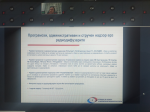 Skopje, 25 December 2020 – The Agency for Audio and Audiovisual Media Services held its last public meeting for this year, today, which was conducted online using a videoconferencing link due to the current COVID-19 pandemic. At the meeting, Agency Director Dr. Zoran Trajcevski made a summary of the activities realized in accordance with the Annual Work Programme in the past three months.
Skopje, 25 December 2020 – The Agency for Audio and Audiovisual Media Services held its last public meeting for this year, today, which was conducted online using a videoconferencing link due to the current COVID-19 pandemic. At the meeting, Agency Director Dr. Zoran Trajcevski made a summary of the activities realized in accordance with the Annual Work Programme in the past three months.
The participants in the meeting had an opportunity to hear about the activities related to the monitoring of the election process for the 2020 Early Local Elections, the monitoring over broadcasters, operators of public electronic communications networks, print media publishers and providers of on-demand AVMS, as well as the imposed public warning measures, the prepared analyses and studies, and activities in the field of international cooperation.
Also presented at the meeting were the key findings on the employee structure in the audio and audiovisual media sector in 2019. This analysis provided an overview of the data regarding the total number of employees in the public broadcaster and the commercial television and radio stations. The data were analyzed in terms of the jobs they had been hired for, their employee status (full-time or part-time employment), gender, degree of education and ethnicity.
In 2019, the number of employees in this industry was 2,601 people, of whom 814 were employed in the public broadcasting service, 1,382 – in the commercial television stations, and 405 – in the commercial radio stations. Out of a total of 2,601 people, 1,546 were men and 1,055 were women. A total of 2,012 people were employed on a regular basis, while 589 people were hired on a part-time basis. Most of the employees had higher education – 1,280, while 1,265 had secondary education, and only 56 people had another level of education. Most of the men were hired as production staff (582 people), while most of the women worked as journalists (507 people). In terms of ethnicity, 1,886 of the employees were Macedonians, 548 Albanians, 52 Turks, 21 Roma, 13 Vlachs, 46 Serbs, 27 Bosniaks, while eight were of other nationalities.
